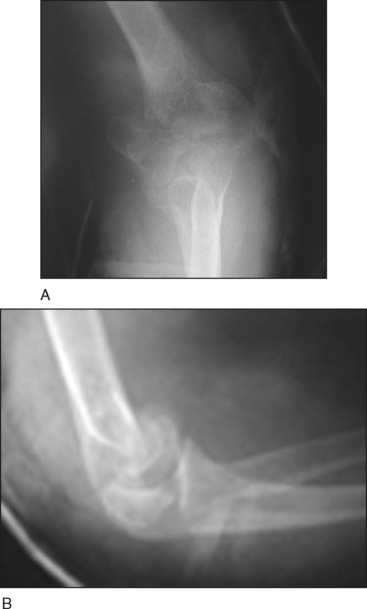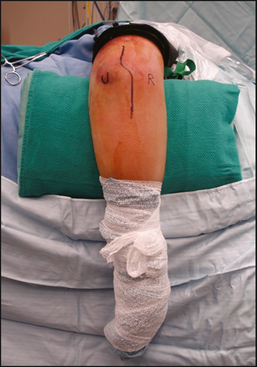PROCEDURE 7 Supracondylar Humeral Fractures
Indications
 Total elbow arthroplasty (TEA) provides good to excellent results in carefully selected patients with comminuted distal humeral fractures.
Total elbow arthroplasty (TEA) provides good to excellent results in carefully selected patients with comminuted distal humeral fractures. Poor bone quality and osteoporosis, which are often found in elderly patients, can lead to inadequate fixation and mechanical failure following open reduction and internal fixation (ORIF). In addition, articular comminution and cartilage fragmentation may preclude anatomic reduction. The ideal candidate for TEA is an elderly patient with a comminuted intra-articular distal humeral fracture.
Poor bone quality and osteoporosis, which are often found in elderly patients, can lead to inadequate fixation and mechanical failure following open reduction and internal fixation (ORIF). In addition, articular comminution and cartilage fragmentation may preclude anatomic reduction. The ideal candidate for TEA is an elderly patient with a comminuted intra-articular distal humeral fracture. Distal humeral fractures in patients with underlying rheumatoid arthritis or pre-existing arthrosis are best managed with primary TEA.
Distal humeral fractures in patients with underlying rheumatoid arthritis or pre-existing arthrosis are best managed with primary TEA.Examination/Imaging
 A common pitfall is to focus immediately on the obvious injury. Examination of the shoulder and wrist is a must.
A common pitfall is to focus immediately on the obvious injury. Examination of the shoulder and wrist is a must. A careful neurologic evaluation that includes motor and sensory functions of the ulnar, radial, and median nerves is critical.
A careful neurologic evaluation that includes motor and sensory functions of the ulnar, radial, and median nerves is critical. The vascular status of the arm should be evaluated by palpation of the distal pulses and assessment of capillary refill.
The vascular status of the arm should be evaluated by palpation of the distal pulses and assessment of capillary refill. Plain radiographs are universally the initial study of choice.
Plain radiographs are universally the initial study of choice.• Figure 1 shows the preoperative anteroposterior (Fig. 1A) and lateral (Fig. 1B) radiographs of a 68-year-old woman with a comminuted intra-articular distal humerus fracture.
 Additional traction views or computed tomography maybe obtained in selected cases. Typically, when TEA is chosen, advanced imaging studies are not required.
Additional traction views or computed tomography maybe obtained in selected cases. Typically, when TEA is chosen, advanced imaging studies are not required.Surgical Anatomy
 The nerve runs down the anterior compartment of the arm medial to the brachial artery and gives off no branches in the upper arm.
The nerve runs down the anterior compartment of the arm medial to the brachial artery and gives off no branches in the upper arm. At the middle of the arm, it pierces the intermuscular septum and travels along the medial head of the triceps.
At the middle of the arm, it pierces the intermuscular septum and travels along the medial head of the triceps. Before entering the forearm, the ulnar nerve gives off capsular branches to the elbow joint, the first motor branch to the flexor carpi ulnaris (FCU), and branches to the ulnar half of the flexor digitorum profundis.
Before entering the forearm, the ulnar nerve gives off capsular branches to the elbow joint, the first motor branch to the flexor carpi ulnaris (FCU), and branches to the ulnar half of the flexor digitorum profundis.Positioning
 We prefer to place the patient in the lateral decubitus position with the injured arm up (Fig. 3). The affected elbow is supported over a bolster.
We prefer to place the patient in the lateral decubitus position with the injured arm up (Fig. 3). The affected elbow is supported over a bolster. A deflatable beanbag is used to secure the patient in place. Great care is taken to pad all bony prominences.
A deflatable beanbag is used to secure the patient in place. Great care is taken to pad all bony prominences. The arm is prepped and draped to the shoulder so that a sterile tourniquet can be applied as high as possible.
The arm is prepped and draped to the shoulder so that a sterile tourniquet can be applied as high as possible. After the extremity is exsanguinated, the tourniquet is inflated. The pressure is set at 250 mm Hg, or 275 mm Hg for an obese arm.
After the extremity is exsanguinated, the tourniquet is inflated. The pressure is set at 250 mm Hg, or 275 mm Hg for an obese arm.Portals/Exposures
• A Hohmann retractor can be used on either side of the humeral shaft to “lift up” the shaft for exposure, rather than levering on the soft tissue excessively. This is especially important on the lateral side where the radial nerve courses proximally.
Stay updated, free articles. Join our Telegram channel

Full access? Get Clinical Tree














